Working with KPIs
A KPI (Key Performance Indicator) is a data container based on a business view for displaying KPI value together with a chart to help illustrate the value. This topic introduces what objects a KPI can contain and how you can create KPIs in a report.
![]() You cannot use KPIs in page reports.
You cannot use KPIs in page reports.
This topic contains the following sections:
Objects in a KPI
You can add the following objects in a KPI:
- Aggregations and formulas as the KPI values.
- Labels to describe the values and as the KPI title or description.
- Images to decorate the KPI or used as logo.
- A KPI chart to assist the KPI values, for example, to show the trend of total sales over time. You can include at most one KPI chart in a KPI. A KPI chart does not have the legend and axes compared to normal Logi Report charts. You can insert a KPI chart in a KPI only and the KPI chart should inherit the dataset from the KPI. A KPI chart can be one of the following chart types: Bar, Bench, Line, Area, Pie, or Bullet.
A KPI is bound with a business view so the KPI value and KPI chart in it are both based on this business view. You can position and resize the objects in a KPI freely by dragging them inside the KPI.
Inserting KPIs in a Report
To create a KPI in a web report or library component, take the following steps:
- Position the mouse pointer at the destination where you want to insert the KPI. You can insert a KPI in a web report or library component as listed in Component Placement.
- Do either of the following:
- From the Components panel, drag the KPI icon
 in the Visual category to the destination.
in the Visual category to the destination. - Select Insert > KPI.
- Select Home > Insert > KPI.
- From the Components panel, drag the KPI icon
- In the Choose Data dialog box, select a business view in the current catalog to bind with the KPI and select OK.
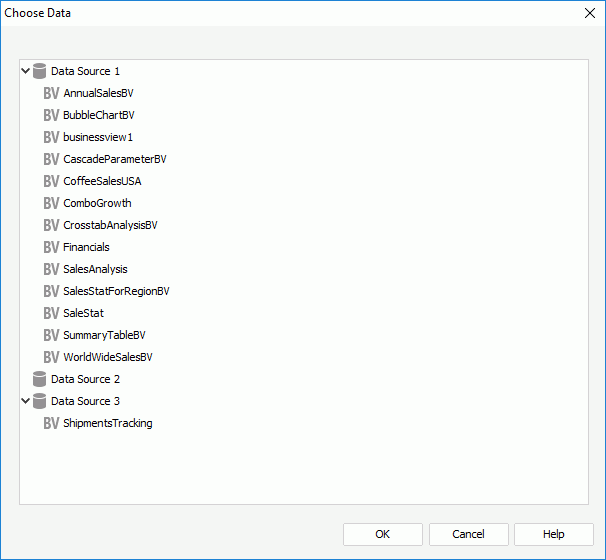
- Designer inserts a blank KPI at the destination. You can then define the KPI by adding objects into it.

- Drag an aggregation or a dynamic formula from the Data panel as the KPI value. Designer adds the name label of the object at the same time by default. You can edit the label text.
- Insert a KPI chart to demonstrate data about the KPI value as follows:
- Right-click in the blank area of the KPI and select Insert KPI Chart from the shortcut menu. Designer displays the Create KPI Chart dialog box.
- The Data screen shows that the KPI chart inherits the business view bound with the KPI. You cannot change the business view.
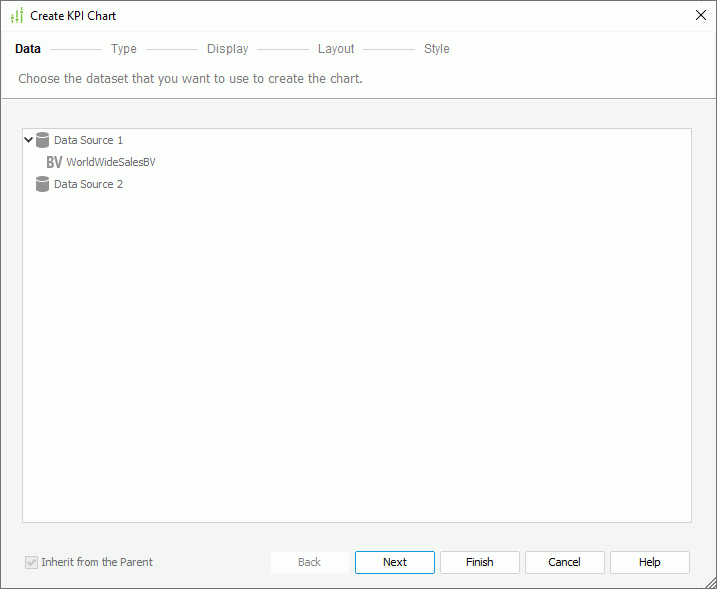
- In the Type screen, select a 2-D Bar, Bench, Line, Area, Pie, or Bullet chart type.
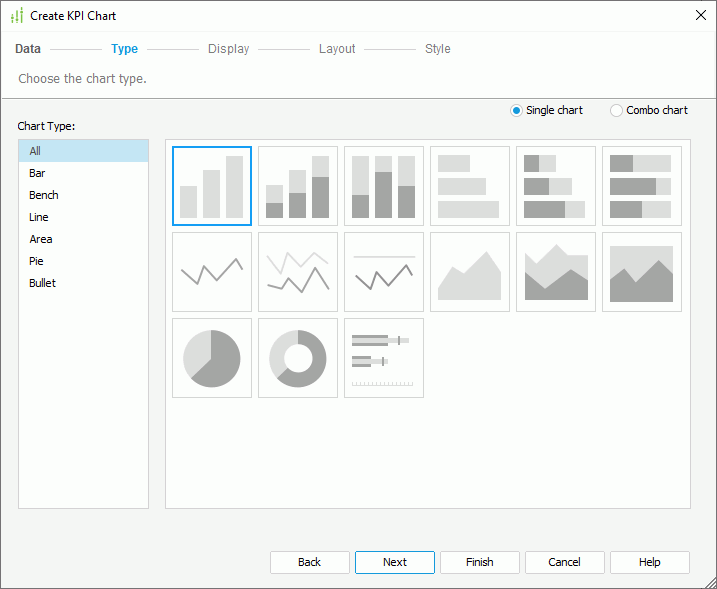
- In the Display, Layout, and Style screens, define the chart as you would do for a general chart.
- Select Finish to insert the chart into the KPI.
- You can add more aggregations, dynamic formulas, labels, and images into the KPI.
- Resize the KPI and the objects in it and adjust the position of the objects by dragging to improve the layout.
After you have created a KPI in a report, you can further edit the objects in it according to your requirements. The KPI chart in a KPI supports most of the operations that you can apply to a general chart. For example, you can modify its definition using the KPI Chart Wizard dialog box, add link to its data markers, and format its paper, platform, wall, label, and data markers (bars/benches, lines, areas, pies, or bullets). If you want to remove the KPI chart, select the KPI, right-click and select Remove KPI chart on the shortcut menu.
Example of Creating a KPI
The following example uses a KPI to show total sales:
- Make sure SampleReports.cat is the currently open catalog file. If not, select File > Open Catalog to open it from
<install_root>\Demo\Reports\SampleReports. - Select File > New > Web Report to create a blank web report.
- From the Components panel, drag the KPI icon
 in the Visual category to the destination.
in the Visual category to the destination. - In the Choose Data dialog box, select WorldWideSalesBV in the current catalog to bind it with the KPI and select OK.
Designer inserts a blank KPI at the destination.
- In the Data panel, create a dynamic formula named "KPI_TotalSales" with the following expression. Use it as Aggregation.
if (@"Orders Detail.Total Sales">=1000000)
ToText(@"Orders Detail.Total Sales"/1000000, "$#,###.00")+"M"
else if (@"Orders Detail.Total Sales">=1000)
ToText(@"Orders Detail.Total Sales"/1000, "$#,###.00")+"K"
else
ToText(@"Orders Detail.Total Sales", "$#,###.00") - Drag the formula from the Data panel to the KPI as the KPI value.
- Right-click in the blank area of the KPI and select Insert KPI Chart from the shortcut menu.
- In the Create KPI Chart dialog box, go to the Display screen, add the group object Sales Quarter to the category axis, the aggregation object Total Sales to the value axis, then select Finish to insert the KPI chart.
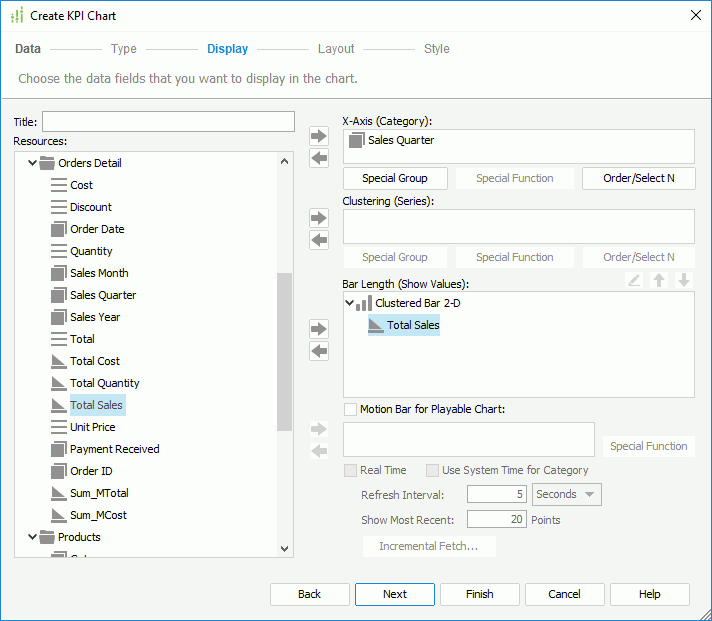
- Adjust the position of the inserted objects. Widen the formula label and field so that the label and value can fully display.
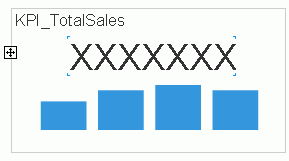
- Select the View tab to preview the real data.
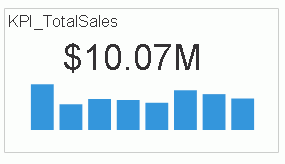
 Previous Topic
Previous Topic